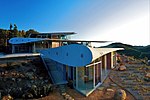1973 Point Mugu earthquake
1973 earthquakes1973 in California1973 natural disasters in the United StatesEarthquakes in CaliforniaFebruary 1973 events in the United States ... and 3 more
Geology of Ventura County, CaliforniaHistory of Ventura County, CaliforniaNatural history of the Santa Monica Mountains
The 1973 Point Mugu earthquake occurred at 06:45:57 local time on February 21 in the Point Mugu area of southeastern Ventura County of southern California. It had a moment magnitude of 5.8 and a maximum Mercalli Intensity of VII (Very strong). This oblique-slip shock resulted in several injuries and $1 million in damage. The epicenter was near the Oxnard Plain and the northern terminus of the Santa Monica Mountains, in the California South Coast region.
Excerpt from the Wikipedia article 1973 Point Mugu earthquake (License: CC BY-SA 3.0, Authors).1973 Point Mugu earthquake
Geographical coordinates (GPS) Address Nearby Places Show on map
Geographical coordinates (GPS)
| Latitude | Longitude |
|---|---|
| N 34.04 ° | E -119.03 ° |
Address
Ventura County
California, United States
Open on Google Maps









